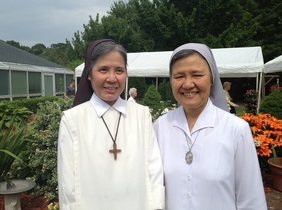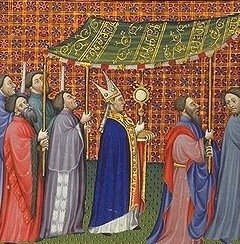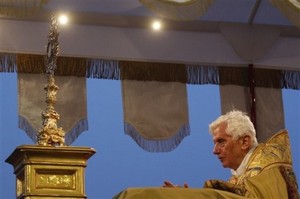Trust in the Lord and do good, and you will dwell in the land and be secure.
Find your delight in the Lord, and he will grant your heart’s desire.
(Ps 37; Introit for Mass for Religious)
These days there are celebrations of profession of vows and recognition of 50 years of monastic profession. The vocation to the monastic life is the search for God (cf. Rule of St Benedict) by the serious living of the gospel and one’s baptism. It is a glorious vocation, one that entering the narrow gate is not easy but eloquent for its witness.
Three friends are living their vocation with fresh eyes. Each called by the Lord to follow and to be see-ers of the Kingdom (cf. Ratzinger) in this manner is sacrificial oriented to life eternal (cf. Spe Salvi, 12).

Benedictine Brother Pietro, a monk of the Monastery of Saint Peter and Paul (outside Milan, Italy) professed his first vows (temporary profession), Father Hilary of the Abbey of Saint Mary (Morristown, NJ) celebrated his 50th annviersary, and Benedictine Sister Marie Rita celebrated her 50th anniversary of profession of monastic vows. There are several others I could mention but let me satisfy this desire to recognize the sign of profession for service of the Kingdom and one’s salvation.
Brother Pietro studied medicine and follows the lay ecclesial movement of Communion and Liberation. His monastery is a diocesan rite monastery following the Rule of SaInt Benedict and the teachings of the Servant of God Father Luigi Giussani. Pietro gave up a promising career in medicine to follow and seek the face of Christ more intimately in an Italian monastery. I can’t help but think of Pietro’s vocation as a witness poignant today in postmodern Italy where monasteries are virtually empty. His monastery receives postulants regularly and I am grateful for his YES.
Father Hilary is a monk and a priest of Morristown, NJ’s Abbey of Saint Mary where he teaches in the Delbarton School and he works in the community as novice and formation director. In the American Cassinese Congregation of monks the 50 year julibilarian receives from the abbot the baculus (a craved stick; this one is made in Ireland) with the liturgical phrase exhorting the monk, “Use the baculus not so much as a support for bodily strength, but rather to obtain spiritual fortitude from our Savior, Jesus Christ, who has called us all to himself in the gospel, saying, Come to me all you who labor and are burdened, and I will refresh you, for my yoke is easy, my burden light.” Hilary’s quiet demeanor is a stable form of living the manner set out by the Lord and Benedict.
 Sister Rita is the Prioress of the Monastery of the Glorious Cross, Branford, CT. Her’s is a vocation to lead a group of women who daily surrender to the Lord their health and mobility uniting themselves more and more eucharistically.
Sister Rita is the Prioress of the Monastery of the Glorious Cross, Branford, CT. Her’s is a vocation to lead a group of women who daily surrender to the Lord their health and mobility uniting themselves more and more eucharistically.
At Sister’s Jubilee Mass more than 75 friends attended with spiritual assistance of Father Peter John Cameron, OP celebrating the Mass and preaching, with Abbot Caedmon Holmes, OSB (of Portsmouth Abbey), Father Prior Vincent DeLucia, OP (St Mary’s Priory, New Haven), Father Jacob Restrick, OP (Hawthorne, NY) Father David Borino (Archdiocese of Hartford), Father Robert Usenza (Diocese of Bridgeport and Father Paul Halovich and Deacon Fusco (also of Hartford).
 Sister Rita’s sister Canossian Daughter of Charity Sister Margaret flew in from China where she is a missionary to be present. The Canossian sisters have the great Saint Josephine Bakhita as one of them.
Sister Rita’s sister Canossian Daughter of Charity Sister Margaret flew in from China where she is a missionary to be present. The Canossian sisters have the great Saint Josephine Bakhita as one of them.
As you may know, monks and nuns profess the monastic vows of conversion of manners, stability and obedience according to the Rule of Saint Benedict. Benedictines live a life with a quality being subtle.
With the Church we pray,
O God, who inspire and bring to fulfillment every good intention, direct your servants into the way of eternal salvation, and as they have left all things to devote themselves entirely to you, grant that, following Christ and renouncing the things of this world, they may faithfully serve you in their neighbor in a spirit of poverty and humility of heart.
I’ve blogged about Monastery of Saint Peter and Paul (Monastero Ss. Pietro e Paolo), Cascinazza (Milan), before here.












